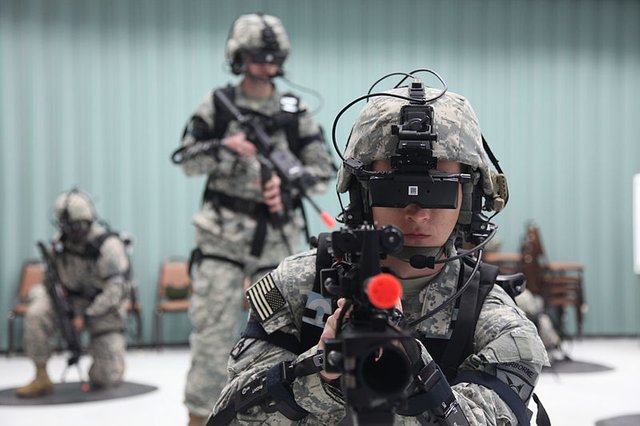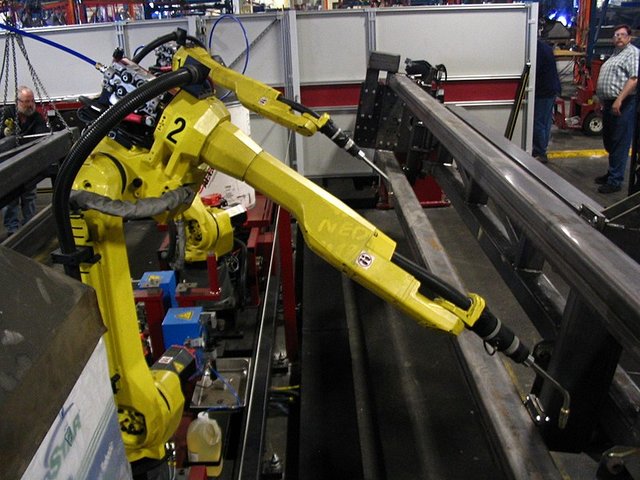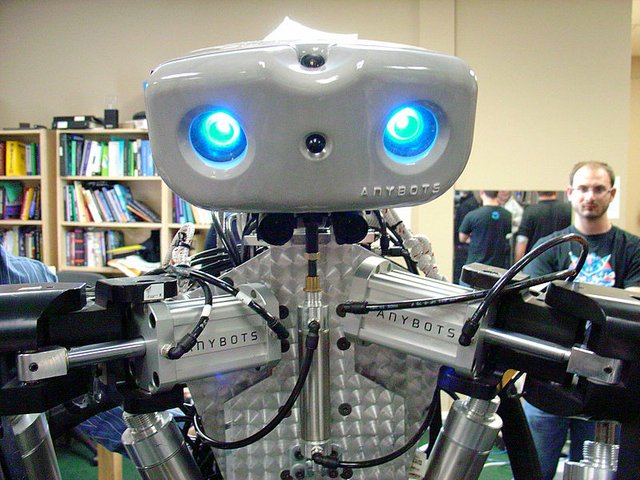Virtual Reality: Humanity's unknown ally.
Virtual Reality is a kind of technology many of us has in one-way watched sci-fi movies where virtual technology was in play, like the movie Matrix, that's a pure example of a virtual reality technology in play.
VR is a kind of technology that makes it possible for people to experience anything anywhere and anytime in a real-lifescenario called a virtual environment, it is a realistic three-dimensional artificial environment that is created with interactive hardware and software which makes the user to believe he is in a real physical environment when he is not. It tricks and convinces the human brain to believe what is not, it creates a stimulated environment for the user. Instead of viewing a screen directly, users interact and view objects in a three-dimensional environment (3D).
VR technologies has been enhanced and it keeps on developing as time passed by using computer technology to create a stimulated none physical 3D environment. Scientists and engineers have designed series of devices and applications that has made this possible.
In VR, 3D images appear to be life-sized from the users view, and
It can monitor and track user's motions, and it stimulates many of the human senses like vision, feeling, hearing, sense of touch, and even sense of smell.
![]()
In VR, the user experiences the feeling of being in a virtual world or environment, he can interact with the environment he is in a more meaningful way as it is in real life which is tagged as Telepresence. Jonathan Steuer explained it as ''a state in which one feels present in a mediated environment rather than the real physical environment''.
in other words, an active VR experience makes one to become unaware of his real physical environment and focuses more on the virtual environment he is in.
In VR, head mounted displays are used with headphones and hand controllers to give a fully immersive experience, with tech companies around the globe investing billions of dollars to further improve VR, I can say that VR is set to be a "cannot leave without" in our everyday lives.
Some elements of a VR.
Virtual, imaginary or artificial world- This is a 3D environment that makes it look as if you are in real life, it changes your environment making your brain to assume you’re in a place that you are not. It’s an unreal environment where one can interact with others, it mimics real life experience in an unreal world.
Immersion -
VR immersion is the perception of being physically present in a none physical world or environment (telepresence). This makes the human brain to believe it’s in a place which it’snot. The state of total immersion happens when the sensory organs are activated to create an experience or perception of being in none physical or none existing environment.
Sensory Feedback -
In as much as simulation is involved in a VR environment, it also requires all our senses to be fully simulated. A sensory feedback can be achieved by stimulating many of the human senses as possible like vision, feeling, hearing, sense of touch, and even sense of smell. Properly stimulating the human senses requires sensory feedback, which is achieved through integrated hardware and software.
Interactivity -
Interaction is crucial for VR experience to provide users with the comfort to naturally engage with the virtual environment. Without this the virtual environment will be seemingly uncomfortable for the user, the user needs to interact with the virtual environment as it is in real life, this brings about the excitement needed in the virtual environment.
Types of VR,
A whole lots of VR technologies has been in play in today's world, ranging from non-immersive VR, Immersive VR and Semi-immersive VR and all this category have areas and fields where they are applicable and where they can be used.
Non-immersive VR -
These are the list immersive of all the VR technologies. This works by using a desktop system, the virtual environment is viewed by using a standard high-resolution monitor. Interaction with the virtual environment happens by conventional means, using a keyboard, mouse or any 3D interaction enhancing device.
It does not require any highest level of graphics performance, so no special hardware is required and be implemented using high specification computers possibly a workstation. This is the lowest cost VR implementation solution, they have low performance compare to recent ones. More so, these systems are of little use especially where perception of scale is of outmost importance. However, one would want to see an increase in the popularity of such VR systems in the future and this is because VRML (Virtual Reality Modelling Language) is meant to be an adopted standard for rendering 3D model data and virtual environments via the web.
Semi-Immersive Simulations -
This is a relatively new VR technology implementation, it was conceived from technologies in flight simulation fields, it provides total immersive experience and it is powered by high performance graphical super computer systems which often comes with-
- A large screen monitor,
- A large screen projector system and
- Multiple television projection systems
to properly stimulate the user's visuals.
This kind of VR system comes with a cost, setting up a big projector system is far more difficult than setting up a desktop system and its more expensive to implement.
Fully Immersive Simulations (Head-Mounted Display Systems) -
This is the most widely used immersive implementation of VR technology in use today. the user wears a Head-Mounted Display (HMD) or Binocular Omni-Orientation Monitor (BOOM). HMD displays, and motion sensors are used to simulate all the user’s senses, it uses small monitors unlike the previous two that makes use of larger monitors that are placed in-front of the eyes which can provide stereo and bio-cular or monocular images. This system provides realistic real-life user experiences, it has a higher resolution, high refresh rate and high contrast rate. Most of HMD displays use LCDs but more expensive HMDs displays are made of CRT (Cathode Ray Tube) for higher resolutions. The HDM is very fanciful and handy that one can easily carry it about with ease. Fully immersive VRs are the most demanding because of their computing power, they are high tech and can give the user a high level of satisfactory and realism.
How Does a VR system work
For the human brain to be tricked to believe what is not real, it must really look real and feel real. This can be achieved using (HMD) that displays a recreated 3D artificial or virtual environment.
In a VR environment, the user usually has this feeling of being in an unreal environment that looks real, he interacts with his environment as it is in real life. The goal is to create a real-life 3D virtual environment without having to experience any difficulties, this in turn eliminates the use of televisions and desktops.
Some Key Components that make up a VR system
PC/Console/Smartphone -
VR content which is what users view inside a VR headset is of importance. In order to power a VR environment, computing power is of a priority because its what really makes the VR environment interesting, they act as an engine house to power the content being produced in the VR environment.
Head-Mounted Displays (HMD) -
This is the device that contains the displayed virtual content. Some VR HMD makes use of Smartphone displays and they are often come with a headset for audio stimulation.
Input Devices
This is the devices that provide the user with the sense of immersion, they make the brain to believe and act in an artificial environment thinking it’s in the real world. Devices like the track pads, motion tracker, motion platforms, data gloves, joysticks among others can be used to achieve this.
Working Principle of a VR Headset
Inside any HMD are series of sensory mechanism or sensors, lenses, display screen and a whole lot of other components. Video is sent from the console, Smartphone or PC to the HMD, there are two lenses which are placed between the two eyes. The can be adjusted to fit the eye. This lenses reforms the pictures for each eye, creating a 3D image for the user mimicking a real world view. VR HMD can increase immersion by increasing how wide the picture is (the field of view), but most HMD come with 100 or 110-degree field of view. The VE works in real time with the sensors in full function. The sensory simulation must be consistent if the user is to feel immersed within the VE.
Inside a VR Head-Mounted Display are sensors. These sensors are what really do the job
Sensors -
There are three common sensors used in a VR HMD, they all work together.
Magnometer sensor -
this directs and tell your device the direction its facing on the surface of the earth. Its like a compass and works with the principle of magnetic field.
Accelerometers -
This tells the device how high it is.
Gyroscopes -
This is responsible for the orientation of the device. It enables the device orientation to change in respect to the direction you move. it ensures that the device orientation changes when it should change.
Lenses -
They lie between your eyes and the pixels in the display screen. They are responsible for auto focus of pictures by angling two 2D images to mimic how each of ht eyes views it. The lenses on each VR HMD can be adjusted at will to suite the user.
Display Screen - This shows the imaged that the user views through the lenses, they are Liquid Crystal Display (LCD) or Organic Light-Emitting Diode (OLED) made. They receive video feeds from the computer, console or Smartphone via wireless connection or HDMI which is then sent to the display.
Processing -
Just like every other computing devices, VR requires processing power to enable it work efficiently.
Input Processor - this controls how information input are carried out on the device, they retrieve and distribute data to system for processing.
Simulation Processor - this handle the simulation aspect, it takes the user inputs in the real world environment and then processes it into action in the virtual world.
Rendering Processor - This creates the sensation that is output to the user. It’s the part that creates the real fun in a VR system.
VR systems have gone far beyond gaming, even before the gaming era VR has been in use in the military, hospitals and a whole lots of areas.
VR in the military
Virtual reality has been in use in the military, both in the Army, Navy and Airforce. Its mostly used in training sessions to train soldiers on how to combat dangerous situations they might encounter without causing harm or death to themselves. The use of VR in the military has proven to be safer, more productive, reduces loss of life to soldiers and less costly than the normal traditional training methods.

USES
VR is used in the following areas in the military
-Flight simulation
-MEdic training in the battlefield
-Vehicle simulation
-Virtual boot camp etc.
VR in healthcare system
VR has been heavily adopted in our healthcare system today, surgery simulations, robotic surgery, skills training and lots more.
It allows healthcare professionals to learn new skills in a safe environment without endangering the patients. It enables doctors, nurses and other medical experts to interact, they engage in training sessions which involves the patients in a 3D VR environment without endangering them.
Its used in robotics surgical operations controlled by human surgeons which reduces time and complications.
VR in construction industries
VR can be very useful in building construction which can really reduce the risk involve in using having machines by engineers. Using a VE, one can create a resulting structure in 3D and also experience them as they would appear in real world. Not only can the viability of a building be tested, engineers and construction workers can be able to send feedback from designs made before its implemented and also to ascertain if workers can fit in the space provided. The construction of a building can be simulated in a VR environment before implementation to know how it will look like in a real world environment.

In near future, I think that VR will be mostly used in construction and engineering works because it save time and also less costly and a higher output within a short period of time can equally be achieved.
Other Areas Where VR Are widely Used Are As Follows
Fashion Designing.
Entertainment Industry.
Sports.
Telecommunication Industry.
Media Industry. etc
Reference:
virtual reality
what-is-virtual-reality
how-does-vr-work-explained
application of VR
